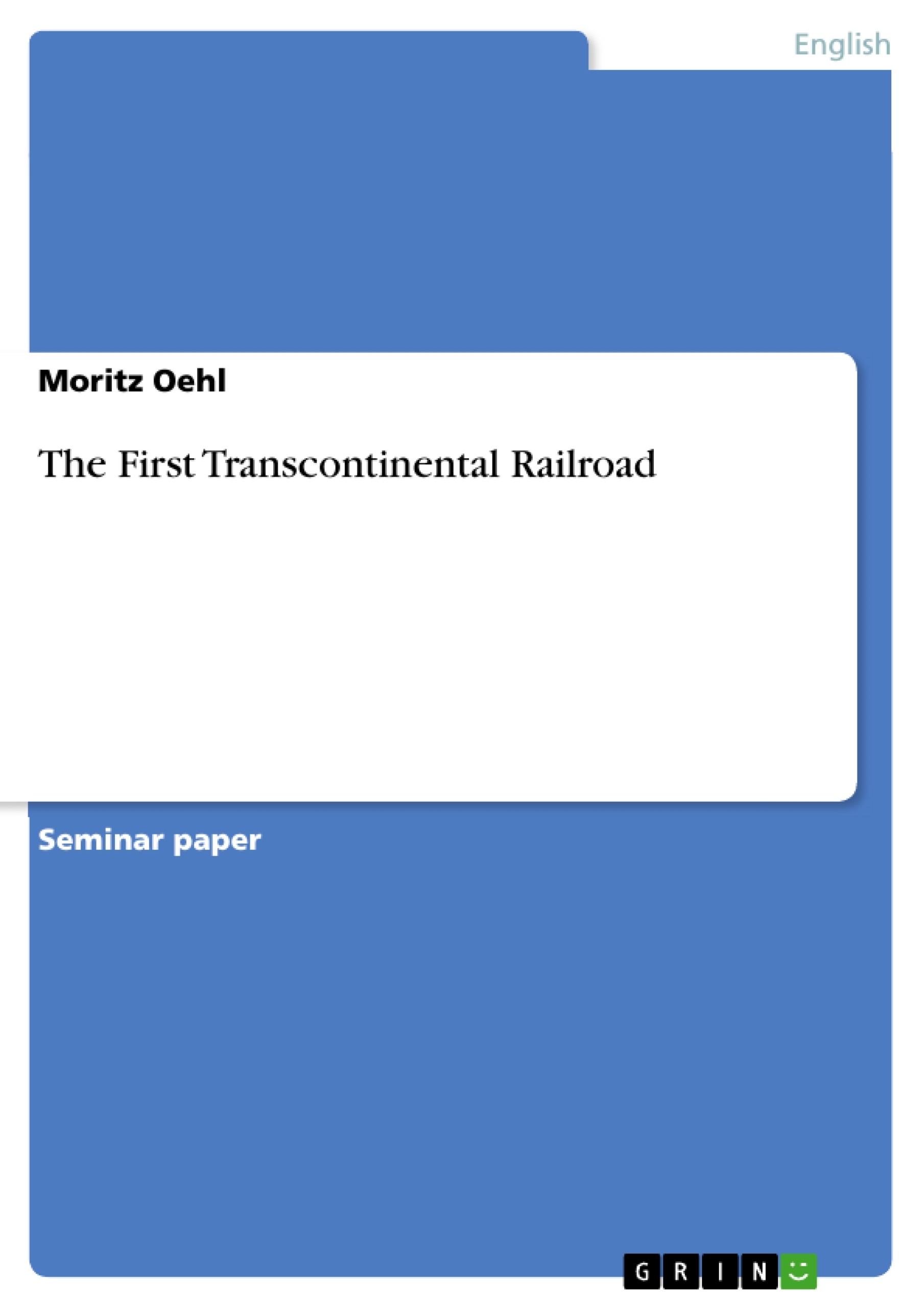1. Introduction
The building of the first Transcontinental Railroad marks one of the highlights in American History. Nearly 20,000 workers, mostly immigrants or Chinese, especially engaged for this job, had build a line stretching from Omaha, Nebraska, to the eastern boundary of California within just six years. This largest project in the history of American transportation cost about $ 50 Mio., a number not reached ever before. Huge discussions preceded the project, even more were held afterwards. This termpaper will deal with the preparations for, the actual work and the consequences of this enormous construction.
[...]
Table of Contents
1. Introduction
2. Still a long way to go
2.1 The System of Transportation in the US before 1860
2.2 Importance of a Transcontinental Railroad
2.3 The Preparations begin
3. Linking the Oceans
3.1 Working Details and Methods
3.2 The Welding of the States
3.3 Consequences of the first Transcontinental Railroad
4. Summary
Bibliography:
1. Introduction
The building of the first Transcontinental Railroad marks one of the highlights in American History. Nearly 20,000 workers, mostly immigrants or Chinese, especially engaged for this job, had build a line stretching from Omaha, Nebraska, to the eastern boundary of California within just six years. This largest project in the history of American transportation cost about $ 50 Mio., a number not reached ever before. Huge discussions preceded the project, even more were held afterwards. This termpaper will deal with the preparations for, the actual work and the consequences of this enormous construction.
2. Still a long way to go…
2.1 The System of Transportation in the US before 1860
Until 1825, when the Erie Canal was opened, the few existing land routes to the west were very dangerous. Only beyond the Mississippi River transportation on roads was suitable, for there the rivers were bad to travel on.
By 1860 the system of railroads in the U.S. was only well developed in the regions of the thirteen first colonies and in the Midwest. The only way into the North American interior was along the waterways. The railways which existed just reached as far as the Mississippi (South) and the Missouri (North, St. Joseph).[1]
Abbildung in dieser Leseprobe nicht enthalten
Fig. 1: US railway system by 1860[2]
2.2 Importance of a Transcontinental Railroad
As Americans realized that there were lands, natural resources and lots of possibilities in the West, first thoughts of constructing a railway to Oregon arose. The first person to start the public discussion of building such a Transcontinental Railroad was Asa Witney, a New York merchant, in 1845. He was convinced that without this railway the then independent region of Oregon would separate and become a sovereign state. Witney therefore addressed the following to the 28th Congress:
“[…] the time is not far distant when Oregon will become a State of such magnitude and importance as to compel the establishment of a separate Government – a separate nation, which will have cities, ports, and harbors, all free, inviting all the nations of the earth to a free trade with them; when they will control and monopolize the valuable fisheries of the Pacific; control the coast trade of Mexico and South America, of the Sandwich Islands, Japan, and all China, and be our most dangerous and successful rivals in the commerce of the world. But your memorialist believes that this road will unite them to us, enabling them to receive the protecting care of our Government, sharing in its blessings, benefits, and prosperity, and imparting to us our share of the great benefits from their local position, enterprise and industry.”[3]
But Congress took no definite action. Time went on and public thought changed: Was Oregon the best solution regarding the western end of the railway?
On January 24, 1848, an event in California finally determined the path of the route: rich gold deposits, found on the American River, caused another “Goldrush”. The news spread throughout the West and reached the middle and Atlantic states by late summer. “The acquirement of nearly a million square miles of additional territory toward the West and Southwest[4], coupled with the discovery of gold and the resultant overland rush by hundreds of thousands of people, made it apparent to the whole country that a pacific railway had become a pressing necessity”.[5] The situation had changed: now people favoured the Bay of San Francisco as the logical western end of the railway.
2.3 The Preparations begin
The necessity of constructing a line through the mostly unexplored and uninhabited space between the area west of the Mississippi and the Sierra Nevada mountain range became more and more pressing. In 1853 Congress passed an act providing for a survey of several lines from the Mississippi to the Pacific[6]. It took nine more years until the operation finally started: with the creation of the “Union Pacific Railroad Company”, together with the amending Act of 1864, a corporation was authorized to construct a railway from “an initial point on the one hundreth meridian of longitude”[7] to the eastern bay of California. On the other hand, the “Central Pacific Company of California” got permission to start building from Sacramento to the state line. The idea behind this separation was to let the two companies meet each other and form a junction.
[...]
[1] Cf. Handouts Bamberg SS 2001 (2001: 40)
[2] Martin (1992: 47)
[3] Dunbar (1915: 1327)
[4] By the treaty of peace with Mexico in 1848 the US had come into possession of a large region in the western part of the continent now occupied by the states of Arizona, California, Nevada, New Mexico, Texas, Utah, and parts of Colorado and Wyoming
[5] Dunbar (1915: 1333)
[6] Cf. Moody (1919: 122)
[7] Moody (1919: 123)
- Citar trabajo
- Moritz Oehl (Autor), 2001, The First Transcontinental Railroad, Múnich, GRIN Verlag, https://www.grin.com/document/797



